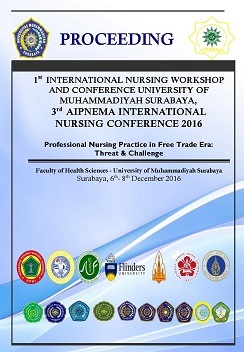The Use Of Nurses` Attribute To Strengthen Children`S Perception Towards Nurses During Hospitalization
Abstrak
Introduction: Hospitalization experience for preschoolers develops children’s negative perception of the nurse. Kids have false perception because nurses’s dutiesare often seen as a daunting process. This false perception can make children afraid and phobias with attributes attached to the nurse, such as, a white shirt or vest of health workers.  Efforts to increase positive perceptions of the nurses need to be done to reduce traumatic to the treatment process. One method that can be used is to modify the official vest of nurses’ preferred using animation vest. Objective: To analyze the effect of animated vest worn vests of nurses toward child’s perceptions to the nurse during hospitalization. Method: This study used a quasi-experimental design posttest-only non-equivalent control group. The analysis of the data used Chi-Square with nominal data scale, was performed to examine the effect of the intervention. Samples were 34 preschoolers who were divided into 17 groups of 17 control and intervention groups. The sampling techniquesin this study was consecutive sampling. Result: It showed a significant effect of the use of animated vest display on the perception of the child to the nurse with a value of P = 0.002. Positive perception was found 70.6% in the intervention group andnegative perception was found 82.4%in the control group. Conclusion: Children express positive perceptions toward nurses by using words such as funny, beautiful, nice and happy, while expressing negative perceptions by using words such as afraid and bad. Improvement of children perception towards nurse is proven to be effective by modifying a vest with colorful cartoon characters.
            Â
Keywords: Perception, Preschool Children, Nurse, Animated VestReferensi
Albert, N. M., Wocial, L., Meyer,K.H., Na, J., & Trochelman, K. (2008). Impact of nurses' uniforms on patient and family perceptions of nurse professionalism. Applied Nursing Research, 2, 181–190.
Attwood, B.J., & Attwood, C. (2008). The pasion test. Alih bahasa Daniel Wirajaya. Jakarta: PT. Gramedia Pustaka Utama.
Brock, D, Metaferia, F., & Sumner, E. (2010). Identification required: Public perception of nursing uniforms. 06 Februari 2012.
Dharma, K.K. (2011). Metodologi penelitian keperawatan: Panduan melaksanakan dan menerapkan hasil penelitian. Jakarta: Trans Info Media.
Elias, L. J., & Saucier, D.M. (2006). Neuropsychology clinical and experimental foundations. Boston: Pearson Education, Inc.
Ellis, J.R., & Hartley, C.L. (2004 ). Nursing in today world :Trends, issues & management. Lippincott: Raven Publishers.
Festini, F, Occhipinti, V., Cocco, M., Biermann, K., Neri, S., Giannini, C., et al. (2008). Use of non-conventional nurses’ attire in a paediatric hospital: a quasi-experimental study. Journal of Clinical Nursing, 18, 1018–1026.
Hockenberry, M. J., &Wilson, D. (2009). Wongs’s essentials of pediatric nursing. (8 th ed). St. Louis: Mosby Elseiver.
Lang, P.J., Brandlay M.M., & Curthbert B.N., (1998). Emotion, motivation, and anxiety : Brain mechanisms and psychophysiology.Biol Psychiatry, 44 : 1248-1263.
Potts, N.L., & Mandleco, B.L. (2007). Pediatric nursing: Caring for children and their family. Vol.1. 2th ed. Canada: Thomson.
Ryan-Wenger, N. A., Gardner W. (2012). Hospitalized children’s perspectives on the Quality and Equity of Their Nursing Care. J Nurs Care Qual, 27(1), 35-42.
Roohafza, H., Pirnia, A., Sadeghi, M., Toghianifar,N., Talaei, M & Ashrafi, M. (2009). Impact of nurses clothing on anxiety of hospitalised children. Journal of Clinical Nursing, 18, 1953–1959..
Supartini,Y. (2004). Buku ajar konsep dasar keperawatan anak . Penerbit buku kedokteran. Jakarta: EGC.
Velotis, C.M. (2005). Anxiety disorder and research. New York : Nova Science Publishers.
Wong, D. L., Eaton, M.H., Wilson D., Winkelstein, M. L., & Schwartz, P. (2008).Wong’s essentials of pediatic nursing. (6thed). St Louis: Mosby Co.
Yu, H., Wier, L.M., & Elixhauser, A. (2011). Hospital Stays for Children, 2009. Agency for healthcare research and quality.






